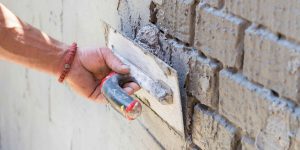
Plaster is a great material for walls, ceilings, and other portions of your home. It’s easy to work with (especially when compared to other materials), it’s inexpensive, and can last for decades if installed properly. But plaster isn’t perfect: The surface may crack or chip over time, and you may need a professional contractor if the damage becomes severe enough. In this post, we’ll talk about the signs that indicate when your plaster needs repair and why it’s important to take action before things get worse! Plaster Repair in Minneapolis MN
What is Plaster?
Plaster is a building material that consists of a binder, usually gypsum, and aggregate. Gypsum is a naturally occurring mineral that can be mined from the ground, but it’s also created by heating limestone to form pellets called “plaster of Paris.” The mixture can be applied to walls or ceilings through either spraying or troweling. Gypsum provides structural strength and flexibility, while aggregate gives the plaster its texture. This combination results in an interior wall finish that will last for years without maintenance—and prevents your home from falling apart during an earthquake!
Plaster takes about 24 hours to fully dry out after application (usually longer in colder climates) so don’t rush any repairs before then. If you’re working on large areas at once like ceilings or walls with multiple rooms connected, you’ll need even more time between coats. Consider making these repairs over several days rather than all at once. This will ensure proper curing time needed between each layer applied before applying new layers again down the road.
Repairing Plaster
If you’ve got paint chips, holes, or even cracks in your plaster, you’ll want to get them repaired. Otherwise, the plaster will continue to fall off the wall and create a safety hazard by having pieces of it fall onto people’s heads.
For example: If there are small holes in your ceiling or walls that allow water to get inside them (especially if they are near windows), then this can cause mold growth and/or moisture damage within the walls/ceilings themselves. Repairs should be done as soon as possible so that further damage does not occur from condensation on surfaces where it is not supposed to be present (such as on topside furniture).
How is Plaster Repaired?
Plaster is a mixture of aggregate and binder. The aggregate is usually composed of sand, lime, and cement. The binder holds the mixture together to form a solid surface. When the plaster dries, it hardens into a flake-free finish that can last for years without cracking or peeling off your wall.
The first step to repairing your plaster is to remove any loose pieces from the wall by hand before you begin any other repairs. You should also use an adhesive stripper or paint thinner to remove any residual glue left in cracks or on seams after removing the previous layer of paint or wallpaper before patching any holes in your walls with new plastering materials like gypsum board panels (drywall).
When the mixture becomes dry and hard, it is sanded down to create a smooth surface. This may be done by hand or with a power sander. Hand sanding requires more time, but it also gives you more control over the finished product. Power sanding usually results in cleaner edges and smoother finishes, but also requires less preparation time than hand sanding. If you choose to do your plaster repair without professional help, we recommend using both methods when possible so that you can compare them side-by-side and determine which works best for each situation at hand!
Wood or Metal Lath
Whether you’re repairing a wall, ceiling, or floor, it’s important to know that plaster can be applied over wood laths or even modern metal laths. Plaster is mixed with water and then smoothed onto the surface you wish to cover. It dries quickly and has no odor when used properly.
Although some people prefer to use hand tools for this process, we recommend working in an area where electricity is available if possible. This will allow you to use power tools such as drills and sanders which can speed up the job considerably.
You will also need an assortment of other materials including buckets for mixing the plaster on-site along with brushes made specifically for spreading plaster evenly over surfaces such as walls or ceilings (these come in different sizes depending upon what type of surface they’re being used on). If you’re working on large areas like ceilings then it may also be helpful if someone else brings along some extra hands so they can assist while spreading out the mixture evenly across large surfaces.
When using any type of paintbrush always remember two things: firstly never reuse any disposable item like clothes or paper towels; secondly do not store them anywhere near food products since this could contaminate them with harmful bacteria which cause food poisoning!
Plaster Repair Can Add Years to the Life of Your Home
Plaster is a building material that consists of a binder, usually gypsum, and aggregate. The binder and aggregate are combined with water to create a semi-liquid mixture that hardens as it dries. When you have paint chips, holes, or even cracks in your plaster, you’ll want to get them repaired.
Plaster is easy to repair because it’s just an additive mixture that washes out easily with water. It can be used on most surfaces inside the home including walls, ceilings, and floors.
Plaster Repair in Minneapolis MN
You shouldn’t wait until your plaster looks like it’s falling off the wall before you repair it. You’ll save money, time, and headaches by getting your plaster repairs done when the problem is small. That way, you won’t have to do an entire re-plaster job later on down the road! If you require plaster repair or other construction services, look no further than Home Drywall and Construction in Minneapolis, Minnesota! Contact us today for more information.
